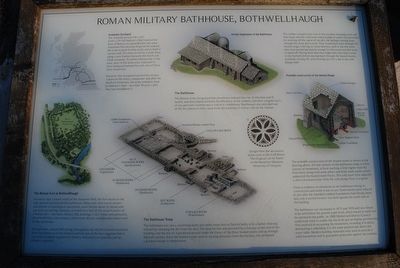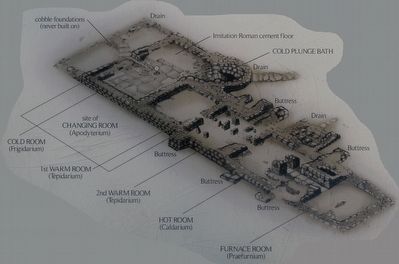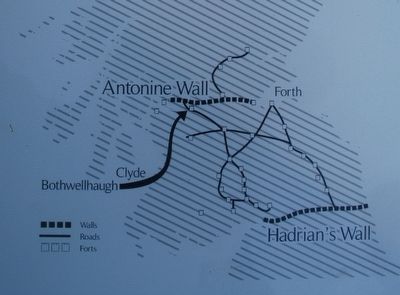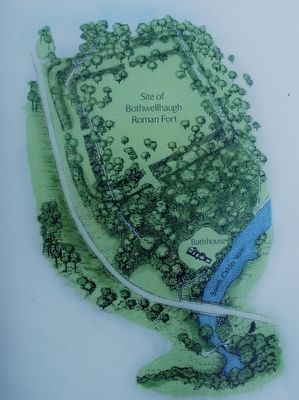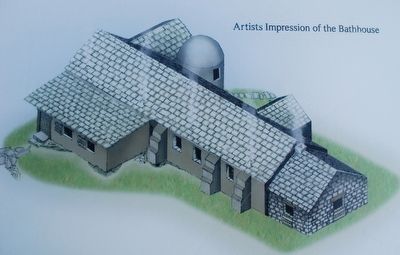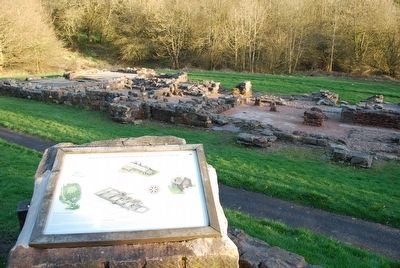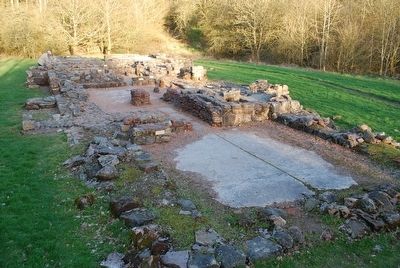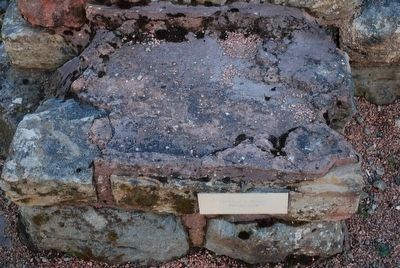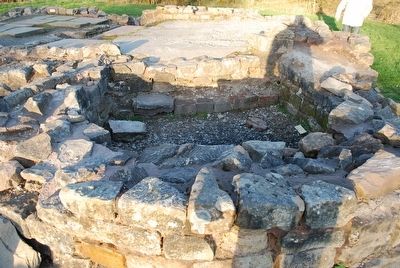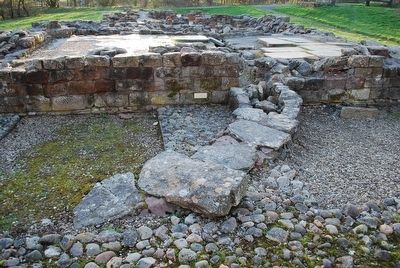Motherwell in North Lanarkshire, Scotland, United Kingdom — Northwestern Europe (the British Isles)
Roman Military Bathhouse, Bothwellhaugh
Antonine Scotland
The Antonine period 140-c.165. Until c.139 AD Hadrian's Wall marked the limit of Roman occupied Britain; but when Antoninus Pius became Emperor he ordered the army to push further north and to build a second wall, this time of turf on a stone base, along a new frontier between the Forth and Clyde estuaries. To enforce Roman law in the area, units of the army were stationed in forts along and behind the wall; one of these forts stood here.
However, the occupation proved too serious a drain on the army's manpower and after the death of Antoninus, the army withdrew back to Hadrian's Wall - less than 30 year's after they had abandoned it.
The Roman Fort at Bothwellhaugh
Situated a day's march south of Antonine Wall, the fort stood on the high ground just beyond the bathhouse. Today only faint traces remain and despite archaeological excavation, exact details about its layout and garrison are lacking; however, it would have had all the usual features of a Roman fort - barracks, blocks, H.Q. buildings, C.O.'s house and granaries, all defended by a clay rampart, one or two ditches and wooden towers over its four gateways.
The garrison, around 500 strong, belonged to the AUXILIA (units recruited from the provinces of the Empire) and the size of the fort suggests that it was either a mixed regiment of infantry and cavalry or possibly just an infantry regiment.
The Bathhouse
The Roman army recognised that cleanliness reduced the risk of infection and ill health, and thus helped maintain the efficiency of the soldiers; therefore a regular part of any garrison's routine was a visit to it's bathhouse. Bathhouses also provided one of the few places to relax, away from the hardship of military life on the frontier.
The Bathhouse Today
The bathhouse was not a swimming baths but rather more akin to Turkish baths with a bather cleaning himself by seating dirt from his skin. The heat for this was provided by a furnace at one end of the building, and the hot air it produced passed under the floors of the three heated rooms and up through the wall cavities. Since the heated rooms were at varying distances from the furnace, this produced a gradual change in temperature.
The soldiers would first strip in the wooden changing room and then move into the cold room where basins of water were provided for washing off the worst of the dirt, the spillage running away through the stone drain cover. They would then move through the heated range, relaxing on stone benches, until in the hot room they were perspiring heavily enough for the sweat and dirt to be scraped off. Having done that they might then have had a wash in the hot bath before moving back through the heated rooms, gradually cooling off, and finishing up with a dip in the cold plunge bath.
The probable construction of the heated rooms is shown in the drawing above. All that remains of the bathhouse today is a few courses of stonework, at best reaching a little higher than the floor level, along with some pillars and brick work stacks which supported the heated room floors. The cold room floor adjacent is also a reconstruction. Only the cold plunge floor is original.
There is evidence of alterations to the bathhouse during its construction and while it was in use. Some rooms were reduced in size after the intended cobbled foundations had already been laid, and a second furnace was built against the south side of the building.
The bathhouse was excavated in 1975 and 1976 and was found to be well below the ground water level, which meant it could not be opened to the public. in 1980 Motherwell District Council undertook work to enable the site to be put on display permanently. This involved re-excavating the monument, recording it in detail, dismantling it rebuilding it in the same position but above the water table. Modern building materials were used to provide a solid foundation and to guarantee protection against the weather.
(Captions)
Design from the decorative drain cover in the Cold Room. The Original can be found in the Hunterian Museum, University of Glasgow.
Artist Impression of the Bathhouse
Probable construction of the Heated Range
Topics. This historical marker is listed in these topic lists: Forts and Castles • Settlements & Settlers.
Location. 55° 47.856′ N, 4° 1.69′ W. Marker is in Motherwell, Scotland, in North Lanarkshire. Touch for map. Marker is in this post office area: Motherwell, Scotland ML1 3RT, United Kingdom. Touch for directions.
Other nearby markers. At least 8 other markers are within 26 kilometers of this marker, measured as the crow flies. 'The Most Magnificent Ruin in Scotland' (approx. 4.4 kilometers away); Betrayed & Captured (approx. 14.9 kilometers away); Wallace's Well (approx. 14.9 kilometers away); Spirit of Scotland Monument (approx. 23.3 kilometers away); Battle of Loudoun Hill (approx. 23.4 kilometers away); Antonine Wall Rough Castle (approx. 24.4 kilometers away); The Antonine Wall (approx. 24.6 kilometers away); a different marker also named The Antonine Wall (approx. 24.7 kilometers away).
Also see . . .
1. Bothwellhaugh Roman Fort. Wikipedia entry (Submitted on September 12, 2015, by Brandon Fletcher of Chattanooga, Tennessee.)
2. Bothwellhaugh,Roman bath house. Ancient Monuments
entry (Submitted on September 12, 2015, by Brandon Fletcher of Chattanooga, Tennessee.)
3. Excavation of a Roman Bathhouse at Bothwellhaugh, 1975—76. Edinburgh University Press entry (Submitted on September 12, 2015, by Brandon Fletcher of Chattanooga, Tennessee.)
Credits. This page was last revised on January 27, 2022. It was originally submitted on September 12, 2015, by Brandon Fletcher of Chattanooga, Tennessee. This page has been viewed 718 times since then and 39 times this year. Photos: 1, 2, 3, 4, 5, 6, 7, 8, 9, 10. submitted on September 12, 2015, by Brandon Fletcher of Chattanooga, Tennessee. • Andrew Ruppenstein was the editor who published this page.
